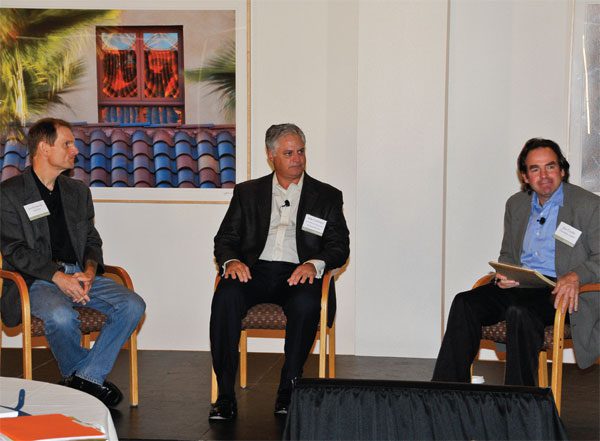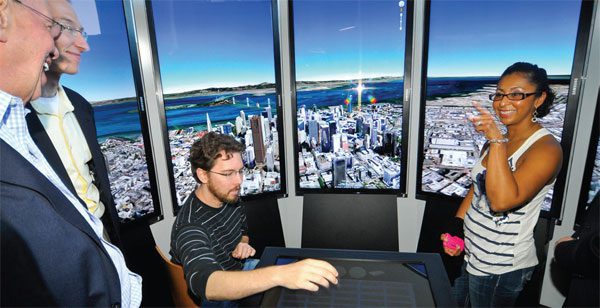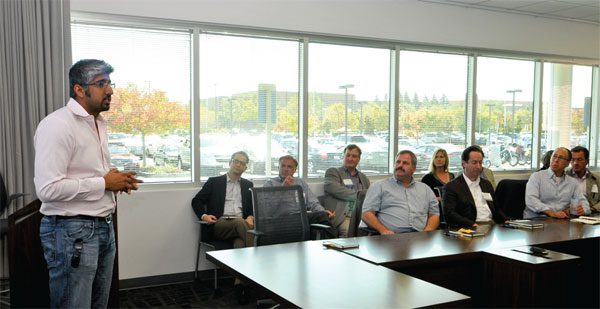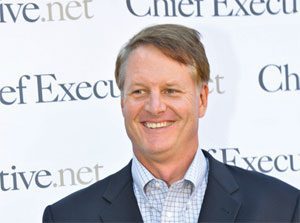
In November, more than 65 CEOs gathered in Silicon Valley to assess how mobile, cloud, social media and analytic technologies are altering the ways companies and consumers function on a daily basis—and ultimately transforming the competitive landscape. In partnership with the Stanford Graduate School of Business Executive Education, Chief Executive hosted one of its signature CEO-only events at Stanford’s Schwab Residential Center and just-completed Knight Management Center. participants compared notes about the impact of technological advances and how best to leverage emerging technologies. The pages to follow offer highlights from the event that can help you understand, assess and leverage the technological forces currently reshaping markets and business models.

Michael Saylor, CEO, MicroStrategy
Transformative technology is hardly a new concept. From the automobile and the calculator to the personal computer and the iPod, in every decade there are one or more examples of innovations that disrupt markets. In short, there’s nothing all that new
“Starting in 2009—I would date it to the Apple 3GS—we saw a triple tsunami hit,” Michael Saylor, CEO of the software company MicroStrategy, told CEOs gathered for Chief Executive’s CEOtech event. “It’s three waves, all of them constructively feeding on each other and they are the mobile wave, the social wave and the cloud wave.”
Saylor went on to predict that the confluence of smart phones, social media and cloud computing would redefine markets and business models. “We’ve already got five billion people around the world with mobile phones, so it doesn’t take a rocket scientist to figure out that sometime between now and the next 10 years or so you’ll see five billion smartphones on the planet,” noted Saylor. “Those five billion people will be running software on those phones 24 hours a day, seven days a week. You’ve got yours with you right now and if I get too boring, you’ll get out your phone and start doing something else.”
But the implications go far beyond solutions for boredom, added Saylor, who notes that an untethered consumer is an empowered consumer. “They don’t have to comply with your monopoly business practices,” says Saylor. “They can walk into a store and check prices. In fact, they can check prices from their living rooms or anywhere they happen to be. And your worst enemy doesn’t have any of your overhead. Amazon doesn’t have real estate or property taxes to contend with, and they’re not particularly concerned with whether they’re compatible with the $100 million point-of-sale hardware you purchased five years ago.”
If mobile phones make things vapor, social media makes them viral. The nearly one billion people in Facebook’s network already represent a powerful database, and one with a powerful differentiator—it self-updates. “People change their names, they move, they change email addresses, employers,” notes Saylor. “And when they do, they update their files. Think about the value of all of the yellow pages and white pages printed by all the phone companies on Earth concentrated.”
And then came cloud. The power of cloud computing can be hard to grasp—and suitably so since it is, after all, in the ether. To illustrate the exponential impact of mobile+social+cloud, Saylor references the 16-year-old girl in Egypt whose videotape of soldiers beating a woman went global. The viral element of the story is clear—she shares the video with friends on Facebook or Twitter, her friends share it with their friends who share it with theirs and so on. “But did you ever try to broadcast a video to 25 million people?” points out Saylor. “If you did that 10 years ago on your home server underneath your desk, it would have crashed as soon as 300 people hit it at the same time. The cloud is where that power comes from.”
As Saylor spoke, heads nodded. Across industries, business leaders agree that the confluence of personal communication platforms with mobile telephony and cloud capability pose serious challenges to how business will be conducted in the future. The question still up for debate is how to meet those challenges.

Pandora’s Joe Kennedy, Wolters Kluwers’ Mike Sabbatis and Crosslink Capital’s Jim Feuille
The nature of disruptive technology is that it throws both businesses and their marketplaces into flux. From a CEO’s perspective, you’re either the new guy looking to use an innovation to knock the established players off the field or you’re the established guy looking to defend your turf by getting ahead of the next curve–but not so far and fast that you crash and burn. In either case, you never know how the game will play out until the dust settles. At CEOtech’s Technology’s Impact on Strategy session, we heard from CEOs at both ends of that spectrum who embraced new technology to forge a future for their businesses and, when field cleared, emerged from the fray as victors.
Here are brief recaps of the stories they shared with CEOtech attendees.

The Challenger: Pandora CEO Joe Kennedy
The Business: Pandora provides personalized Internet radio over computers, phones, and other devices connected to the Web. “Instead of trying to find a station that works for you, you enter the name of a song or artist or composer or genre that you like and Pandora creates a station that plays that kind of music,” explains Kennedy. “Through your interactions—thumbs up, thumbs down— you then personalize the service to suit your taste.”
The Technology: The Music Genome Project—a database of the attributes of music that enables the company to connect listeners to tunes they will like and musicians to new audiences.
The Challenge: Conceived around selling software to music retailers, Pandora (then known as Savage Beast Technology) was in crisis and headed for insolvency when Kennedy took the helm in 2004. “In scanning the landscape, we found that 80 percent of the time people spend listening to music they’re not playing their own music; they’re listening to the radio,” says Kennedy. “And, hey, we had this intellectual property that would enable us, we believed, to be the best in the world at bringing personalization to radio.
The Competition: Broadcast radio. “Radio towers have specific locales and reach out for a hundred miles, it’s very much a local kind of business built on FCC licenses,” says Kennedy. “And the broadcast world in which all of us grew up is a one-to-many, one-way technology. The Internet enables us to address all markets simultaneously and to give each person have a completely unique, personalized experience.”
The Hitch: Pandora initially pursued a subscription-based revenue model—a strategy that proved flawed. “Radio, the category that we’re disrupting, is overwhelming ad-supported free and has been for 100 years,” says Kennedy, who notes that after a few months of subscription model the company began offering free ad-supported radio.
The Lesson: “Think twice before you change the basic economics for the end user,” says Kennedy. “I also think that we got that wrong because no one here had been part of an ad supported business before. If we had a team comprised of people who fully represented the ranges of experiences of the market we were seeking to disrupt, we would have been more comfortable going in that direction earlier on.”
The Endgame: Introduced six years ago, Pandora now has 100 million registered users, and recent data showed 37 million active listeners in a trailing 30-day period. It went public in June of 2011 and has released a run rate of around $250 million a year in terms of revenue.

CCH CEO Mike Sabbatis
The Business: A division of $4.8 billion Wolters Kluwer, CCH is a leading provider of tax accounting, audit and workflow information, software and services with more than 700 publications in print and electronic form.
The Challenge: “We had a large legacy business built with old systems and old processes that we needed to migrate to new technology,” says Sabbatis. “So first, we needed to digitize all our information, everything you wanted to know about accounting law or tax law. Second, we needed a process to make our applications mobile—to moved our distributed software, all of our client server applications, into the cloud.”
The Competitive Landscape: Accounting work has historically been paper- and software-intensive. “Ten years ago you would see auditors with crates and crates of documents,” says Sabbatis. “And our program for income tax alone is more than 20 million lines of code—trying to take those applications mobile was a big, big challenge for us.” Yet, the benefits of being able to offer access to information and applications anytime from anywhere was clear—a strategic, competitive advantage for CCH. “The barriers to entry were high, but you have to understand that somebody will figure out a way to get there,” notes Sabbatis.
The Hitch: CCH’s revenues depended on maintaining its legacy system, yet the company needed to transition to new technology. “In 2006, we decided to build a new house from the foundation up, because the old plumbing that was in there wasn’t going to get us to the Net, to the Smartphone, to where we needed to go. It involved a very challenging sale to our board of directors because it was a very expensive proposition—a $70 million investment for a $600 million company.”
The Lesson: “Talk to your customers and understand how they’re working, and talk to your perspective customers to understand what they’re looking for,” urges Sabbatis. “You’ve also got to be disciplined and diligent in driving data-driven decisions, whether they be about technology, cost or infrastructure. I will promise you that whatever you put together as a business plan, you will have an overrun on cost. So if I had to do it over again, I would have broken it up into a shorter, more consumable bites so that you accomplish something at a cost you can control and can continue to make that investment going forward.”
The Endgame: “Looking back, it was probably the best decision we could have made because it’s gotten us where we are today with a fully enabled cloud application anytime, anywhere across the globe,” says Sabbatis. “Multinational firms that had hundreds of instances of our application in offices around the globe can now have one instance of it on our system. And on the smaller end of the market, a sole practitioner who hasn’t got an IT budget or IT staff can have the power of this program at their beck and call just by logging on and going.”
CEOtech attendees were treated to a tour of Googleplex, Google’s sprawling headquarters in Mountain View, Calif.—also known as the most entertaining workplace in America, and possibly on Earth. Famous for its dining facilities (all food free to all Googlers) and high-tech relaxation devices, including a sound and lightproof decompression chamber, the Googleplex campus is also outfitted with more traditional downtime activities like volleyball courts, bicycles, swimming pools, gym equipment and Foosball tables. And, of course, it’s green— solar powers supply approximately 30 percent of daily power needs and charge the company’s fleet of plug-in hybrid vehicles. Tour participants were most impressed with the sheer scale of the campus and the way it and Google’s employees reflects corporate culture—a self-contained world inhabited by casually dressed, youthful employees who each play a role in the functioning of this giant colony.

Participants ready to be wowed.

Google demos its immersive 3D map of the future.

Google’s Shan Sinha shares insights on the power of cloud computing—and how Google can help you harness it.

Henry Nothhaft
Former CEO, Tessera
“Many companies have not extended their business model to mobile, making them vulnerable and leveling the playing field to new entrants. It is imperative for companies to adopt mobile strategies and embrace cloud computing as mobile online commerce ramps up dramatically at faster adoption rates than fixed Internet is achieving. By mid-decade, mobile will account for 4 percent to 6 percent of all retail sales. That’s an amazing number.”

Julie Ask
VP, Forrester Research
“Your mobile phone will soon know more about you than any other device or person. You’re reading books, banking, programming your DVR and making purchases on this device. Many [uses] involve your current location, even your altitude and speed, whether you’re walking, running, driving. I think of this not as big brother so much as a big mother—your device is here to care for you and help you make good decisions.”

Alexander Yoder
CEO, Webtrends
“A lot of organizations, whether it’s their marketing teams or their CIOs, are struggling with the concept of how to actually drive measurable value and insight from [mobile and social] channels, as well as throwing a lot of dollars at having to have a mobile strategy or a social strategy and not really realizing that a) they aren’t building measurement into it to begin with, so they’re failing before they even start, and b) the fundamental problems they’re trying to solve are really not that dissimilar to those customer marketing and interaction challenges experienced 10 years ago.”

Strolling to the Knight Management Center on Stanford’s campus
What social media should CEOs be using—and what should they be saying on them? In a session on maximizing the ROI of social media participants discussed best practices for employing social media in all aspects of business, from marketing to human resources. Panelists Wes Sterman of Pharmacofore, Alex Chang of Roost and Howard Lind of Cicoil shared their experiences leveraging social media to boost profits and manage corporate reputations.

Bend Broadband’s Amy Tykeson

Actv8’s Brian Shuster

Sand Hill Group’s M.R. Rangaswami, Checkster’s Yves Lermusi, Accolo’s John Younger, Social Rep’s Chris Kenton, Socialtext’s Ross Mayfield
Kaiser Permanente’s George Halverson wowed CEOs with an overview of how leveraging technology can revolutionize healthcare. (Note: Look for excerpts of these presentations in upcoming issues of Chief Executive).

Kaiser Permanente’s George Halverson wowed CEOs with an overview of how leveraging technology can revolutionize healthcare.

eBay’s John Donahoe gave insights on the future of e-commerce and online security threats.

Chief Executive Group exists to improve the performance of U.S. CEOs, senior executives and public-company directors, helping you grow your companies, build your communities and strengthen society. Learn more at chiefexecutivegroup.com.
0

1:00 - 5:00 pm
Over 70% of Executives Surveyed Agree: Many Strategic Planning Efforts Lack Systematic Approach Tips for Enhancing Your Strategic Planning Process
Executives expressed frustration with their current strategic planning process. Issues include:
Steve Rutan and Denise Harrison have put together an afternoon workshop that will provide the tools you need to address these concerns. They have worked with hundreds of executives to develop a systematic approach that will enable your team to make better decisions during strategic planning. Steve and Denise will walk you through exercises for prioritizing your lists and steps that will reset and reinvigorate your process. This will be a hands-on workshop that will enable you to think about your business as you use the tools that are being presented. If you are ready for a Strategic Planning tune-up, select this workshop in your registration form. The additional fee of $695 will be added to your total.

2:00 - 5:00 pm
Female leaders face the same issues all leaders do, but they often face additional challenges too. In this peer session, we will facilitate a discussion of best practices and how to overcome common barriers to help women leaders be more effective within and outside their organizations.
Limited space available.

10:30 - 5:00 pm
General’s Retreat at Hermitage Golf Course
Sponsored by UBS
General’s Retreat, built in 1986 with architect Gary Roger Baird, has been voted the “Best Golf Course in Nashville” and is a “must play” when visiting the Nashville, Tennessee area. With the beautiful setting along the Cumberland River, golfers of all capabilities will thoroughly enjoy the golf, scenery and hospitality.
The golf outing fee includes transportation to and from the hotel, greens/cart fees, use of practice facilities, and boxed lunch. The bus will leave the hotel at 10:30 am for a noon shotgun start and return to the hotel after the cocktail reception following the completion of the round.